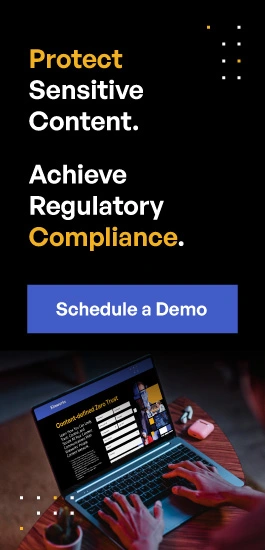GxP Compliance: A Roadmap to Success
GxP compliance is a set of guidelines and regulations related to the various aspects of production, testing, and distribution of pharmaceuticals, biotechnology, medical devices, and other products associated with the healthcare industry. Organizations must have the right cybersecurity risk management strategy to achieve GxP compliance. This article explores the importance of GxP compliance, its purpose, types of regulations, and the necessary steps to maintain compliance.

What is GxP?
GxP is an acronym for “Good Practice” quality guidelines, a set of regulations and standards established by regulatory bodies like the U.S. FDA. The “x” is a variable that represents a specific regulated discipline. For example, ‘M’ stands for Manufacturing (GMP), ‘C’ for Clinical (GCP), and ‘L’ for Laboratory (GLP).
These GXP standards were established to ensure that regulated products are consistently high in quality and safe for human use. It’s helpful to distinguish GxP, the guidelines themselves, from GxP compliance, which is the act of adhering to these stringent rules. Understanding this distinction is the first step in mastering the complex landscape of GxP requirements, which are detailed further in the standards section below.
What Is GxP Compliance?
GxP compliance refers to the regulatory standards set out by Good Manufacturing Practice, Good Laboratory Practice, and Good Clinical Practice. These regulations were developed to ensure that products related to pharmaceuticals, food, and medical devices are safe and effective for human use. GxP compliance requires organizations to have a quality management system and a variety of processes in place for validating processes, training personnel, and maintaining records. The purpose of these regulations is to protect public health by ensuring that medical products are reliable and effective.
Importance of GxP Compliance in Various Industries
Compliance with GxP regulations is essential in the pharmaceutical, biotechnology, and medical device industries as it ensures the safety, quality, and efficacy of products being produced and distributed. GxP compliance is also critical for regulatory bodies, which need to ensure that products being produced, tested, and distributed meet the appropriate standards of safety and efficacy. Additionally, GxP compliance is important for consumers and patients, as these regulations help ensure their safety and health.
Understanding GxP Compliance Standards
The main regulations in the pharmaceutical, biotechnology, and medical device industries include Good Manufacturing Practices (GMPs), Good Clinical Practices (GCPs), and Good Laboratory Practices (GLPs). There also are Good Distribution Practices (GDPs), Good Pharmacovigilance Practices (GVPs), and Good Quality Practices (GQPs).
Good Manufacturing Practices (GMPs)
Good Manufacturing Practices are based on regulations established by the U.S. Food and Drug Administration (FDA), which outline the basic requirements for the manufacture of drugs and other medical products. These regulations are meant to ensure the safety, quality, and effectiveness of these products. GMPs cover a wide range of topics, including personnel qualifications, facility design and construction, production processes, operations, quality control, and product labeling. GMPs are implemented during the manufacturing process to ensure that the product is manufactured correctly and consistently, and that it meets the standards of the manufacturer and of the FDA.
Good Clinical Practices (GCPs)
Good Clinical Practices are a set of international standards that are meant to ensure the safety, rights, and welfare of research study participants, as well as the accuracy and integrity of the data collected from clinical trials. GCPs require that all clinical trials be conducted in a scientifically sound and ethical manner and that the investigator adheres to all ethical and regulatory requirements, including obtaining informed consent from participants.
Good Laboratory Practices (GLPs)
Good Laboratory Practices are a set of regulations designed to ensure the accuracy and reproducibility of data generated in laboratories. GLPs are enforced by the FDA, and they require that laboratories maintain a certain level of quality control in the design, implementation, and oversight of laboratory testing and laboratory protocols. GLPs also require that all laboratory procedures, materials, and equipment used in the laboratory are properly documented, and that all data and results are accurately recorded.
GxP Examples Across the Product Lifecycle
- Research & Development (GLP): A laboratory conducting preclinical safety studies for a new drug must follow Good Laboratory Practices. This includes calibrating all testing equipment on a defined schedule, meticulously documenting every experimental procedure, and having an independent quality assurance unit review the final study report to guarantee data integrity before submission.
- Clinical Trials (GCP): A sponsor running a human trial must adhere to Good Clinical Practices. A key requirement is obtaining and documenting informed consent from every participant, ensuring the trial protocol is approved by an Institutional Review Board (IRB), and accurately reporting all adverse events to regulators in a timely manner.
- Manufacturing (GMP): A facility producing medications must comply with Good Manufacturing Practices. This involves validating the sterilization process for injectable drugs, maintaining a strictly controlled sterile environment with documented air quality, and ensuring all personnel follow gowning procedures to prevent product contamination.
- Distribution (GDP): A distributor shipping temperature-sensitive vaccines must follow Good Distribution Practices. This means using validated cold-chain shipping containers, continuously monitoring and recording temperatures during transit, and keeping detailed records to prove the product’s quality was maintained from the warehouse to the pharmacy.
- Post-Market Surveillance (GVP): After a drug is on the market, the company must follow Good Pharmacovigilance Practices. This includes having a system to collect, assess, and report adverse drug reactions from patients and doctors, demonstrating that GxP oversight protects patients throughout the entire product lifecycle.
The 5 Ps of GxP Explained
- People: All personnel must have the appropriate education, training, and experience to perform their assigned tasks. Their roles and responsibilities must be clearly defined. Tip: Implement a robust, documented training program that includes regular assessments of competency and GxP knowledge.
- Premises: The facility and equipment must be properly designed, located, constructed, and maintained to prevent contamination and operational mix-ups. This includes utilities like air and water systems. Tip: Create and adhere to a strict schedule for equipment calibration, maintenance, and cleaning, with all activities documented.
- Processes: All critical processes must be validated to ensure they consistently produce the expected results. Any deviation from established processes must be documented and investigated. Tip: Use process mapping to identify critical control points and establish monitoring systems to ensure they remain within specified limits.
- Products: This covers all aspects of the product itself, from raw materials to the finished goods. It includes specifications, testing, handling, storage, and distribution to ensure identity, purity, and quality. Tip: Establish a rigorous supplier qualification program and perform thorough incoming material inspection and testing.
- Procedures (and Paperwork): All activities must be governed by written Standard Operating Procedures (SOPs). Accurate and complete documentation (the “paperwork”) is required for every GxP-related action, creating a traceable history. Tip: Utilize a validated document management system to enforce version control, manage audit trails, and ensure data integrity in line with GxP requirements.
Key Principles of GxP Compliance
Quality manufacturing and testing processes must be in place to ensure that the products produced are safe, effective, and meet established standards using the following principles:
1. Quality Assurance
Companies must ensure that products meet quality standards through documented processes and procedures. Any deviations from established standards must be documented and addressed.
2. Documentation
Companies must document all processes, procedures, and decisions related to the production, testing, and storage of products.
3. Training
Companies must provide employees with the necessary training to understand and follow established GxP procedures.
4. Auditing
Companies must have an auditing system in place to ensure that processes, procedures, and decisions are in compliance with GxP regulations.
5. Validation
Companies must validate and verify that processes, procedures, and systems used in the production and testing of products work as intended.
6. Record-keeping
Companies must maintain records of all activities related to the production, testing, and storage of products. These records must be maintained in a secure location and must be accessible to authorized personnel.
Risks of Non-Compliance in GxP
Failure to meet GXP requirements carries severe consequences that extend far beyond simple administrative issues. The most critical risk is harm to patient safety, which can lead to injury or death. Financially, non-compliance can result in substantial penalties, with regulatory bodies like the FDA issuing hundreds of warning letters annually and levying fines that can reach millions of dollars.
Violations often trigger forced product recalls, halting revenue streams and incurring massive logistical costs. Beyond the immediate financial impact, GXP compliance failures cause significant reputational harm, eroding trust among patients, healthcare providers, and investors. The only effective strategy to avoid these outcomes is proactive mitigation, which involves embedding a strong quality culture and robust GxP systems throughout the organization.
The Benefits of GxP Compliance
GxP compliance is an essential part of any quality management system and provides numerous benefits.
1. Cost Optimization
Ensuring GxP compliance reduces the cost of doing business and helps optimize the cost of production.
2. Prevention of Safety Incidents
By following GxP principles, companies can reduce the risk of safety incidents while also knowing they are in compliance with the regulations.
3. Risk Mitigation
Following GxP regulations helps companies to identify, manage, and mitigate risks.
4. Improved Quality
By ensuring quality standards are met, a company is able to provide the best quality product or service to their customers, resulting in improved customer service and satisfaction.
5. Increased Efficiency
Complying with GxP regulations often leads to increased efficiency in operations, as standard operating procedures are better followed.
6. Enhanced Credibility
Being in compliance with GxP ensures that a company is seen as credible and trustworthy, helping to boost its overall reputation.
7. Improved Customer Confidence
Customers have greater confidence in a company that is compliant with GxP regulations, helping to strengthen the company-customer relationship.
8. Better Traceability
A company following GxP principles also has better traceability of data, which is important for a wide range of activities and helps ensure accurate record-keeping.
Best Practices for GxP Compliance
Compliance with Good Practices standards is not easy. Many companies face myriad challenges to keep up. To ensure compliance with GxP regulations, companies must implement best practices.
1. Implement a Quality System
Establish an effective quality system compliant with good manufacturing practices to ensure that the products you develop and manufacture meet the highest standards of quality and safety.
2. Document Procedures and Training
Document all procedures in line with GxP standards and ensure that all relevant personnel are trained and certified to these standards.
3. Establish Quality Assurance
Establish a quality assurance system that includes inspections and audits performed to ensure adherence to GxP requirements.
4. Monitor Equipment and Compliance
Monitor the maintenance, calibration, and testing of equipment to ensure that it is compliant with GxP regulations and standards.
5. Comply With Validation Requirements
Validate all processes, operations, and products to ensure they are compliant with GxP.
6. Monitor Records and Documentation
Monitor all records and documentation to ensure accuracy and compliance with GxP regulations and standards.
7. Monitor Supplier Quality
Monitor the quality of all vendors and suppliers to ensure they are compliant with GxP regulations and standards.
8. Monitor Personnel Practices
Monitor personnel practices to ensure they are compliant with GxP regulations and standards.
9. Invest in Technology
Invest in technology solutions to help with GxP compliance and automation, such as electronic document management systems and process automation solutions.
10. Regularly Review and Update
Regularly review and update GxP compliance practices to ensure they remain effective and up to date with any changes in regulations or industry standards.
GxP Compliance Software Solutions
To effectively manage the vast documentation and process control demands of GxP, organizations often turn to specialized software. When selecting a solution, look for key features such as immutable audit logs to track every action, granular role-based access controls (RBAC) to ensure data security, and comprehensive validation support to prove the system works as intended. For electronic records, readiness for regulations like FDA 21 CFR Part 11 and EudraLex Annex 11 is non-negotiable.
While on-premise solutions offer direct control, modern cloud-based (SaaS) platforms provide greater scalability and faster implementation. Solutions like the Kiteworks Private Data Network are designed to support the GXP compliance pharmaceutical industry by integrating into the existing tech stack, creating a single, secure platform for managing regulated content, automating workflows, and simplifying audit preparations.
GxP Risk Assessment Framework
A GxP risk assessment is a systematic process for identifying, evaluating, and mitigating risks that could compromise product quality or patient safety, as outlined in guidelines like ICH Q9 (Quality Risk Management).
The process begins with identifying potential hazards across the product lifecycle. Common tools like Failure Mode and Effects Analysis (FMEA) are used to analyze manufacturing processes, while Hazard Analysis and Critical Control Points (HACCP) can identify contamination risks. Once identified, risks are evaluated based on their severity and probability. Organizations must then establish clear risk tolerance levels to decide which risks require mitigation.
All findings, risk evaluations, and subsequent mitigation plans must be meticulously documented and integrated into the overarching Quality Management System (QMS), ensuring that risk management is an ongoing, data-driven activity that supports continuous improvement and GxP compliance.
GxP Compliance for Emerging Biotechs
Emerging biotech firms face unique GxP compliance challenges, including limited budgets, small teams wearing multiple hats, and the need to rapidly scale operations as products advance through the pipeline.
A pragmatic approach is crucial. Instead of attempting to implement a massive, enterprise-scale QMS from day one, biotechs should build a phased compliance roadmap. This involves focusing on the GxP requirements most critical to their current stage—for instance, prioritizing GLP during preclinical development and then phasing in GCP controls as they prepare for clinical trials.
Leveraging scalable, cloud-based platforms for document control, training, and data management can significantly accelerate readiness. These solutions provide enterprise-grade compliance features without the heavy upfront investment in infrastructure, allowing small firms to meet stringent GXP standards efficiently and build a solid foundation for future growth.
Who Defines and Oversees GxP Compliance?
GxP compliance is primarily defined and enforced by national and regional regulatory agencies that have legal authority within their jurisdictions. These bodies conduct inspections and can take enforcement action.
Additionally, international organizations develop influential standards and guidelines that are widely adopted by these agencies, creating global harmonization. Key guidance from bodies like the International Council for Harmonisation (ICH), such as ICH Q10 on Pharmaceutical Quality Systems, provides a framework that regulators expect to see implemented. The Pharmaceutical Inspection Co-operation Scheme (PIC/S) also plays a vital role by harmonizing inspection procedures among its 50+ member authorities, ensuring a consistent approach to GxP standards worldwide.
At the national level, countries collaborate with regulatory agencies that provide guidance and set regulations to ensure consumer safety. This is a partial list:
- United States: Food and Drug Administration (FDA)
- European Union: European Medicines Agency (EMA)
- United Kingdom: Medicines and Healthcare products Regulatory Agency (MHRA)
- Japan: Pharmaceuticals and Medical Devices Agency (PMDA)
GxP and Quality Management Systems
A robust Quality Management System (QMS) is the engine that drives GxP compliance. Rather than a simple collection of documents, a QMS is an integrated framework that manages all aspects of quality, with models like ICH Q10 and ISO 13485 providing blueprints for implementation. Essential QMS modules interlock directly with GxP requirements.
For example, the Document Control module ensures that all SOPs used in manufacturing (GMP) are current and approved. The CAPA (Corrective and Preventive Action) system investigates deviations found during laboratory studies (GLP) or clinical trials (GCP) to prevent them from happening again.
Similarly, Training Management modules track and document personnel qualifications, while Audit Management systems schedule and manage the internal and external audits necessary to prove ongoing adherence to all GxP standards.
Electronic Records Requirements in GxP Compliance
Controls for a Closed System in GxP compliance provide guidance on how to maintain the integrity of electronic records used in a regulated environment. These requirements specify that electronic records must be protected from unauthorized access, alteration, and deletion and must be backed up through managed and controlled processes. Organizations must also ensure that audit trails are retained and reviewed, appropriate access controls are in place and documented, and that records must be securely archived. In addition, periodic reviews of system security are also necessary to ensure compliance with regulatory requirements.
Content Tracking and Control of Information Related to Product and Services Quality
The Kiteworks Private Content Network offers an audit trail that provides a secure, computer-generated, and time-stamped record of all information sent and shared internally and with third parties over email, file sharing, managed file transfer, web forms, and application programming interfaces (APIs) in GxP regulated processes. Compliance with “good document practice” regulations and records tracking obligations is a priority, as it allows for safe and effective production of food, medical devices, drugs, and other life science products.
Kiteworks unifies sensitive content communications into one platform and delivers comprehensive tracking and controls that enable organizations to demonstrate GxP compliance.
Kiteworks has a built-in anomaly detection engine to ensure that suspicious users and content behavior are identified and alerted. Integration with security information and event management (SIEM) tools enables organizations to share those alerts as part of a normal security operations center (SOC). Finally, Kiteworks categorizes, classifies, and tags sensitive content communications into classifications that include document types, user and folder access, metadata, and more.
Kiteworks also ensures the integrity of data stored and communicated using ALCOA+ Principles Active by Design. Organizations using Kiteworks, as a result, can avoid regulatory compliance citations for data integrity issues that would apply to content within the Kiteworks Private Content Network.
To understand how Kiteworks enables organizations to comply with GxP compliance requirements, schedule a custom-tailored demo today.

